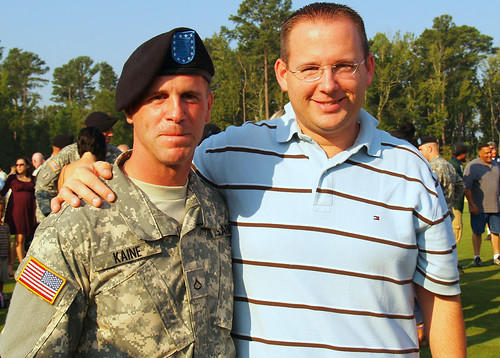Monday, August 31, 2009
Sunday, August 30, 2009
Tuesday, August 25, 2009
Google Traffic: The bright side of sitting in traffic.
What if you could do a little something to improve the world during your daily drive to work? Here are a few ideas: tell everybody in the city when you're stuck in slow-moving traffic; warn the drivers on the freeway behind you that they should consider an alternate route; tell the people still at home that they should spend another ten minutes reading the morning news before they leave for work; tell your city government that they might want to change the timing of that traffic light at the highway on-ramp. Of course, you can't just get on the phone and call everybody, and your one traffic report from your one spot on the road might not help much anyway. But if everybody on the road, all at once, could tell the world how fast their car is moving, and we could make it easy for anybody to check that information on their computer or cell phone, well — then we'd be getting somewhere.
If you use Google Maps for mobile with GPS enabled on your phone, that's exactly what you can do. When you choose to enable Google Maps with My Location, your phone sends anonymous bits of data back to Google describing how fast you're moving. When we combine your speed with the speed of other phones on the road, across thousands of phones moving around a city at any given time, we can get a pretty good picture of live traffic conditions. We continuously combine this data and send it back to you for free in the Google Maps traffic layers. It takes almost zero effort on your part — just turn on Google Maps for mobile before starting your car — and the more people that participate, the better the resulting traffic reports get for everybody.
This week we're expanding our traffic layer to cover all U.S. highways and arterials when data is available. We're able to do this thanks in no small part to the data contributed by our users. This is exactly the kind of technology that we love at Google because it's so easy for a single person to help out, but can be incredibly powerful when a lot of people use it together. Imagine if you knew the exact traffic speed on every road in the city — every intersection, backstreet and freeway on-ramp — and how that would affect the way you drive, help the environment and impact the way our government makes road planning decisions. This idea, which we geeks call 'crowdsourcing,' isn't new. Ever since GPS location started coming to mainstream devices, people have been thinking of ways to use it to figure out how fast the traffic is moving. But for us to really make it work, we had to solve problems of scale (because you can't get useful traffic results until you have a LOT of devices reporting their speeds) and privacy (because we don't want anybody to be able to analyze Google's traffic data to see the movement of a particular phone, even when that phone is completely anonymous).
We achieve scale by making Google Maps for mobile easy to install and use, and by making it easy for people to provide information about their own vehicle speed. There's no extra device to plug into your car and no extra software to buy. Google Maps is free and works with most cell phones, and the number of cell phones with GPS is rising every day. Some phones, such as the T-Mobile myTouch 3G and the Palm Pre, come with Google Maps and traffic crowdsourcing pre-installed (the iPhone Maps application, however, does not support traffic crowdsourcing). Google is fortunate to have a lot of people using our products, and that scale helps make our products better.
We've already been able to provide useful traffic information with the help of our existing mobile users, but we hope that is just the start. As GPS-enabled phones and data plans get less expensive, more people will be able to participate. Crowdsourcing traffic gives us a way to harness bits of location data from our users and give it back to them in a form they can use to make impactful decisions that affect their free time, their pocketbooks and the environment. The more people use it, the better it will get. So next time you're sitting in morning traffic, turn on Google Maps for mobile and let someone else know they can hit the snooze button one more time. Tomorrow morning, they might do the same for you.
Posted by Dave Barth, Product Manager for Google Maps.
Sunday, August 23, 2009
Thunder Hole where as many as 20 people were swept out to sea today in Acadia National Park Maine
A 7 year old girl has died after a wave swept her off the rocks here today. (this is a photo from a few years ago.)
11 of these victims have broken bones and the Coast Guard believes there are other victims still in the water yet to be identified as missing.
Now, I get it: You want to hear the THUNDER at Thunder Hole, but come on, don't actually GO DOWN there with a 7 year old.
Sunday, August 16, 2009
Backup and Search Your Friends' Tweets with Google Reader [Twitter]
 Thanks to a combination of RSS magic and Twitter API, it's possible to search the tweets of everyone in your Twitter network with Google Reader. Here's how to do it.
Thanks to a combination of RSS magic and Twitter API, it's possible to search the tweets of everyone in your Twitter network with Google Reader. Here's how to do it.
First, though, why would you want to do this? The native search tool provided by Twitter only tunnels back about a week and a half. Anything beyond that is lost in the ether. Thanks to a handy little tool created by Dave Winer, you can turn your follower list into an RSS feed and import that feed into Google Reader, which turns the data from the Twitter feeds into a search-friendly mountain of feed items. How do you do it? From ReadWriteWeb:
It couldn't be much simpler. Just put your Twitter username into this link, instead of mine, and load it up in your browser: http://tw.opml.org/get?user=marshallk&folder=1
It may take just a minute, but the end result will be an OPML file. You can either go up to your browser's File menu and select 'save as' or you can View Source and copy and paste the source of the page into a text document. Save it with a memorable name and either .xml or .opml as the file type. It's really quite easy.
Now if you want to put this puppy into Google Reader just log in, click on 'manage subscriptions' and find the import/export button. Import that file into Google Reader and you're ready to rock and roll!
In our test of the service, we were able to mine all sorts of things from the feed we created. How much did our band of followers talk about Texas? Quite a bit more than we expected. Check out the full article at the link below for additional information or use the technique quoted above to jump right in. Have a favorite Twitter-centric hack of your own? Share it in the comments.
Thursday, August 13, 2009
A flurry of features for feed readers
Since our last big launch, we've been thinking about ways to help our users better share, discover, and consume content in Reader. Today, I'm happy to announce several new features that we hope will further improve the way you use Reader.
Send to... We've made it easier to share posts you like to Blogger, Twitter, Facebook, and more, with our new 'Send to' feature. (Incidentally, Blogger is celebrating its tenth birthday this month, and we're hoping our friends there will like this little birthday present.)
We've made it easier to share posts you like to Blogger, Twitter, Facebook, and more, with our new 'Send to' feature. (Incidentally, Blogger is celebrating its tenth birthday this month, and we're hoping our friends there will like this little birthday present.)
Just head over to the settings page, and enable the services you want to use. If your favorite service isn't listed (and you're feeling extra geeky), you can create your own 'Send to' link with a URL template.
To share an item on one of your sites, simply click the 'Send to' button and choose your service. If you're into keyboard shortcuts, 'shift-t' will do the same.
Feeds from people you follow
When we added following, we tried to make it easier to find and follow people who share similar interests. Now we've gone even further, and made it possible for you to subscribe directly to the blogs, photos, or Twitter updates that anyone you're following has included on their Google profile.

To quickly subscribe to these sites, click the 'From people you follow' tab on the 'Browse for stuff' page.
More control for mark all as read We know people can be overwhelmed by too many unread items, and sometimes only want to see recent posts. The 'Mark all as read' button now has a menu that lets you choose to only mark items as read if they're older than your specified time frame. A tip of the hat to Nick Bradbury who pioneered this 'panic button' feature.
We know people can be overwhelmed by too many unread items, and sometimes only want to see recent posts. The 'Mark all as read' button now has a menu that lets you choose to only mark items as read if they're older than your specified time frame. A tip of the hat to Nick Bradbury who pioneered this 'panic button' feature.
Finally, a few small tweaks in this release:
- When you expand an item in comment view, you now get the full set of actions, enabling you to share, like, and star items without leaving comment view.
- We added a 'Feeds' start-page option for the iPhone/Android/Pre mobile interface, so you can see a list of your subscriptions when you sign in.
- There is now an option to show notes when embedding your shared items on other pages as clips.
As always, if you have feedback, please head over to our help group, Twitter, or Get Satisfaction.
Sunday, August 9, 2009
PFC Kaine


After serving our country in the first Gulf War as a Parachute Rigger in the United States Navy, Scott decided he would serve again now during the Wars in Iraq and Afghanistan as a US Army Infantryman. This is him and I after his Pass in Review.
The entire photo set is here.
Shortly after this photo was taken, he gave me the single greatest gift I have every received. More to come on that later.



